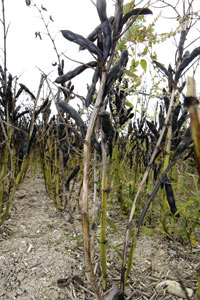Tricky season for bean control in cereals looms

Now that straight mecoprop is no longer registered for use in the autumn, growers with beans in the rotation could find the control of volunteers more difficult to achieve.
This year, more than ever, that could be a problem, believes David Parish of The Arable Group. The adverse conditions that beans went into last autumn mean that many plants formed their pods lower down, making it difficult to harvest them successfully.
“We can expect to see quite high numbers of volunteer beans coming up,” he says. “The fact that they can emerge from depth is also relevant – at the moment they’re more likely to find moisture than the newly drilled wheat crop.”
With beans, there are no control thresholds for growers to work to, he continues. “The real issue with them is that they are competitive and get in the way, especially where you are trying to get a contact-acting herbicide on to small blackgrass plants.
“Beans are very good at shading the target. Their ability to spoil your blackgrass control programme is a bigger problem than their competitiveness with the wheat crop.”
They also tend to be clumpy by nature, adds Mr Parish. “You find them emerging in tight groups of several plants.”
The first thing to do is to make sure that any beans that emerge before the crop is sown are controlled. “That deals with the first flush. But you will still get them coming through with the crop.”
Unfortunately, pre-emergence herbicides are not very effective, he warns. “They might check them. But again, the fact that beans emerge from depth works to their advantage – the pre-emergence herbicide sits in the top inch of soil.”
An early post-emergence application is the answer, although the approach should be tailored to the volunteer population, advises Mr Parish.
“Where you have a low population, which isn’t shielding the black-grass, the early November Atlantis application will do the job. It goes on with oil and a residual partner, so it is effective in conjunction with early winter frosts.”
But a thick population requires a specific treatment before the Atlantis spray, he says.
“There is one herbicide, Pixie, which contains mecoprop and DFF, which can still be used in the autumn,” he reports. “It’s one of the newer mecoprop products, so it still has approval for the next few years. Whether there will be enough to go round remains to be seen.”
Otherwise, there are still some use-up stocks of products containing mecoprop and dicamba lingering this season, but these can only be used when the crop has five leaves.
Where Pixie is used, Mr Parish sounds a note of caution about the amount of DFF in the system. “Don’t forget that DFF is also found in Liberator, so check carefully if oilseed rape is going to be your next crop. Your establishment options could be limited.”
Dick Dyason, of Nufarm, the company which supplies Pixie, confirms there is no other form of mecoprop available for autumn use.
“Pixie doesn’t have either volunteer beans or volunteer oilseed rape on the label, but it does control them,” he says. “For best results, get it on before the weeds are too big, at a rate of 2litres/ha.”
Other weeds
Another broad-leaved weed likely to become more of a challenge without the autumn use of mecoprop is cleavers, says David Stormonth of Interfarm.
The peak of cleavers germination between September and October can be taken care of with flumioxazin – available as Digital, Guillotine and SumiMax – when the weed is first appearing, he says.
“Use it early post-emergence, at 100ml/ha, to get good cleavers control and reduce the likelihood of having to overspray in the spring,” he recommends. “It can be mixed with a useful range of grassweed herbicides and sequenced with any other herbicide or group.”

